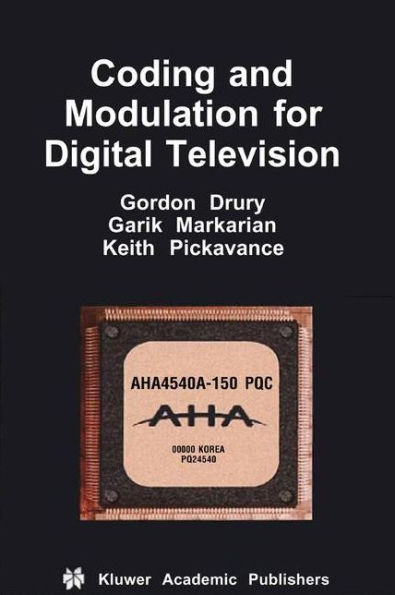Coding and Modulation for Digital Television / Edition 1 available in Hardcover, Paperback

Coding and Modulation for Digital Television / Edition 1
- ISBN-10:
- 1441950052
- ISBN-13:
- 9781441950055
- Pub. Date:
- 12/07/2010
- Publisher:
- Springer US
- ISBN-10:
- 1441950052
- ISBN-13:
- 9781441950055
- Pub. Date:
- 12/07/2010
- Publisher:
- Springer US

Coding and Modulation for Digital Television / Edition 1
Buy New
$109.99Overview

Product Details
| ISBN-13: | 9781441950055 |
|---|---|
| Publisher: | Springer US |
| Publication date: | 12/07/2010 |
| Series: | Multimedia Systems and Applications , #17 |
| Edition description: | 2002 |
| Pages: | 249 |
| Product dimensions: | 6.10(w) x 9.25(h) x 0.24(d) |
Read an Excerpt
Chapter 1: An Introduction to Television
1. Television HistoryTelevision, or seeing at a distance, was visualised with great prescience in the mid-19th century by Albert Robida, a French illustrator. In 1869 the Illustrated London News journal published a drawing by Robida that showed a Gentleman at home, relaxed on his chaise longue, smoking contentedly and enjoying what was declared to be a performance of Faust. For sure this was a worthy, uplifting subject for such a viewer, but the picture shown appears more like a chorus line, dressed in the French theatre style of the time. It is clear that the illustrator had divined immediately what appeal the future technology would have to the viewer and had captured the original couch potato, viewing material more salacious than edifying. Prescient indeed!
Practical "Television" was foreseen quite soon after this, in the "wired" age of the telegraph and the telephone, by Carey (1875) in the USA and Bidwell (1881) in the UK. Lucas, working in England in 1882, realised that some form of image scanning would be required to capture a scene. The dominant technology of the day at this time was mechanical and the first serious practical work in TV derived from the experiments of Nipkow and his rotating disc scanner patented 1884/5. Revolving mirrors for mechanical scanning were proposed by Weiller in 1889. Electronic elements came in 1897 with Braun's CRT (with Fleming's magnetic deflection of 1896) and then in 1907 with Rosing and his hybrid ideas for mechanical image scanning but CRT display. Among the pioneers of purely electronic television was A A Campbell-Swinton in the UK who, around 1910, was advocating CRT technology for both image scanning and display however the technology of the time was not capable of realising his vision.
The essence of practical television, at least to engineers and experimenters, was, and remains, the reproduction of natural scenes and spectacles with sufficient realism and fidelity to the original that the viewer could become engaged with the experience of viewing. Despite the many improvements and innovations in technology during the 20th century this goal has remained a constant challenge and engineers still strive for better quality. It has taken a long time to perfect the TV systems now commonplace around the world but the essential notions of viewing, and of course hearing, at a distance has been substantially achieved. The search for higher technical quality remains today in the quest to improve the resolution of picture detail through High Definition TV but also in the quest for 3D TV where the goal is the equivalent of Surround Sound in sound broadcasting and recording. However the viewer is not necessarily interested primarily in technical picture or sound quality as such. Viewers and broadcasters see the value of TV in the "content" - the programmes and, from a commercial viewpoint, broadcasters and the owners of content, including the film and cinema industry, see TV as a business and the viewer as a consumer.
This was clearly illustrated sixty years later than Robida's vision, in 1929, when the cinema was in full flow with the "Talkies" and television was close to becoming a practical reality. William Paley, Chief Executive of the Columbia Broadcasting System (CBS), one of the largest sound broadcasters in America, envisaged the future of television as follows:
I visualise the world series baseball games, automobile and horse races transmitted the instant they occur on supersized natural colour, stereoscopic screens
Experience had tempered expectations by 1929 but there is some commonality between Robida's vision and that of Paley. It is interesting to observe that both visions have been realised to a large extent in terms of the content of modern television including, as it does, sport and theatre and drama of all kinds and not a little salacity. Paley's vision, another 70 years further on, is almost exact except for the "supersized" and "stereoscopic" screens. It is arguable that the former has been partly achieved if the size of the typical 1929 screen is taken into account. The screen of the first television receivers used in the 1930s was a round faced CRT with a radius of perhaps 15-20 centimetres whereas today's television set has a rectangular CRT screen typically three to four times larger in diagonal. Perhaps it only remains for engineers to perfect a 3D television system to complete the vision.
What Paley perhaps failed to state was that broadcasting, as the means of delivery, was a user of radio spectrum and would be limited in growth unless efficient exploitation of bandwidth was achieved. Despite the advances in picture quality over the years even today the analogue modulation schemes in use for delivery of TV to the vast majority of the world's viewers are little better than those available in the 1930s - mostly simple but inefficient Amplitude Modulation. As the later Chapters of this book will show, digital modulation techniques already enable an explosive increase in the number of TV channels delivered by means of radio spectrum. This will gather pace in the future and...
